Creating beautiful outdoor spaces transforms any property into a personal sanctuary that reflects your style while enhancing curb appeal. Modern landscaping encompasses sustainable practices, innovative design elements, and functional outdoor living areas that seamlessly blend with natural environments. Today's homeowners prioritize eco-friendly solutions, native plant selections, and low-maintenance designs that support local ecosystems while providing year-round visual interest. From contemporary minimalist gardens to lush tropical retreats, the possibilities for landscape transformation are endless. These 25 landscaping ideas showcase diverse approaches to outdoor design, each offering unique features that can adapt to various climates, budgets, and personal preferences for creating stunning exterior spaces.

1. Sustainable Native Plant Garden with Drought-Tolerant Design
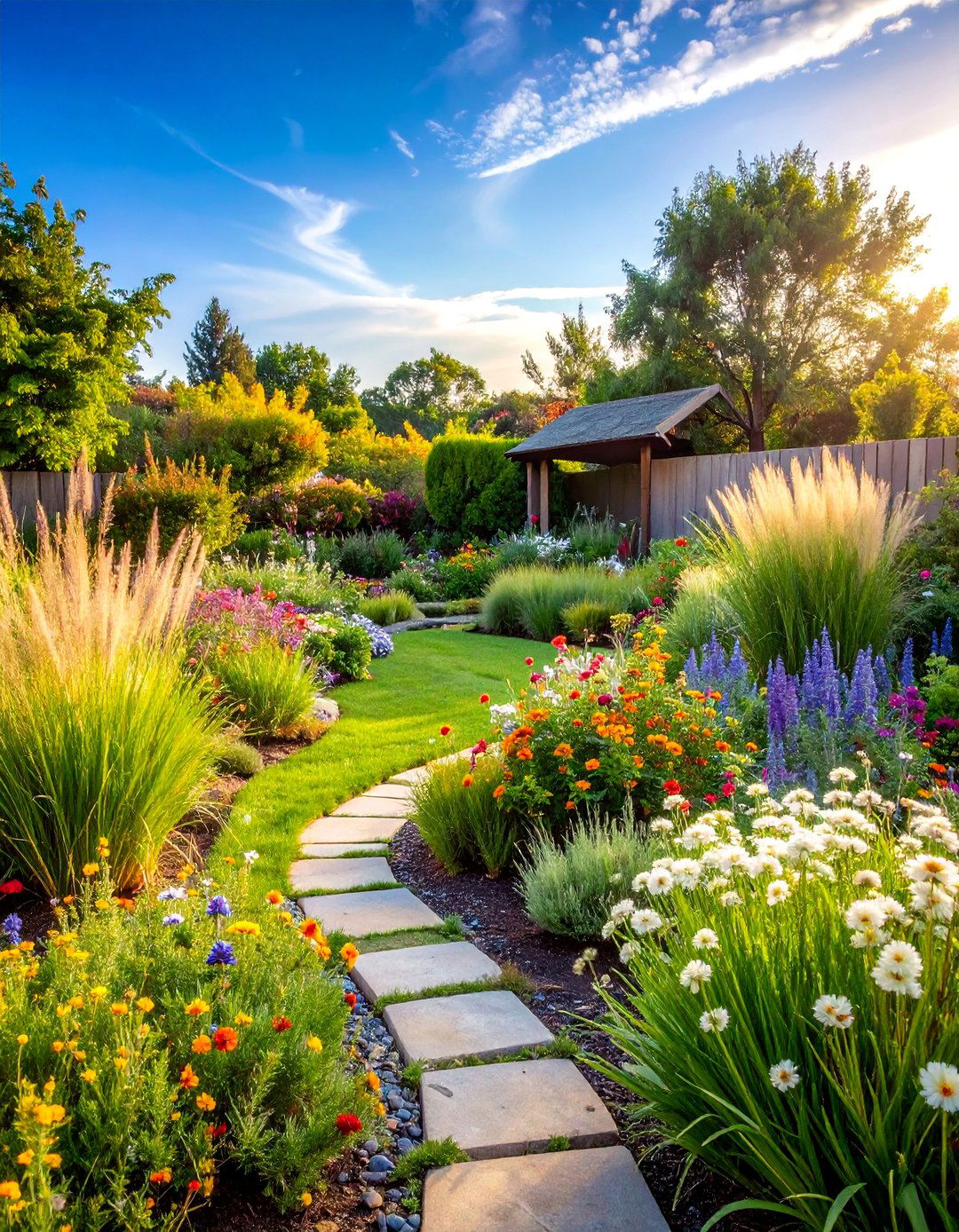
Creating a native plant landscape reduces water consumption while supporting local wildlife ecosystems. This design features indigenous species adapted to your region's climate, requiring minimal irrigation once established. Layer different heights of native grasses, wildflowers, and shrubs to create visual depth and seasonal interest. Include plants like purple coneflower, black-eyed Susan, and ornamental grasses that attract pollinators while thriving in natural conditions. Stone pathways wind through planted areas, connecting functional spaces. Rain collection systems capture natural precipitation for supplemental watering during dry periods. This sustainable approach minimizes maintenance requirements while creating habitat for beneficial insects and birds, making your landscape both environmentally responsible and visually stunning throughout changing seasons.
2. Modern Minimalist Landscape with Clean Geometric Lines
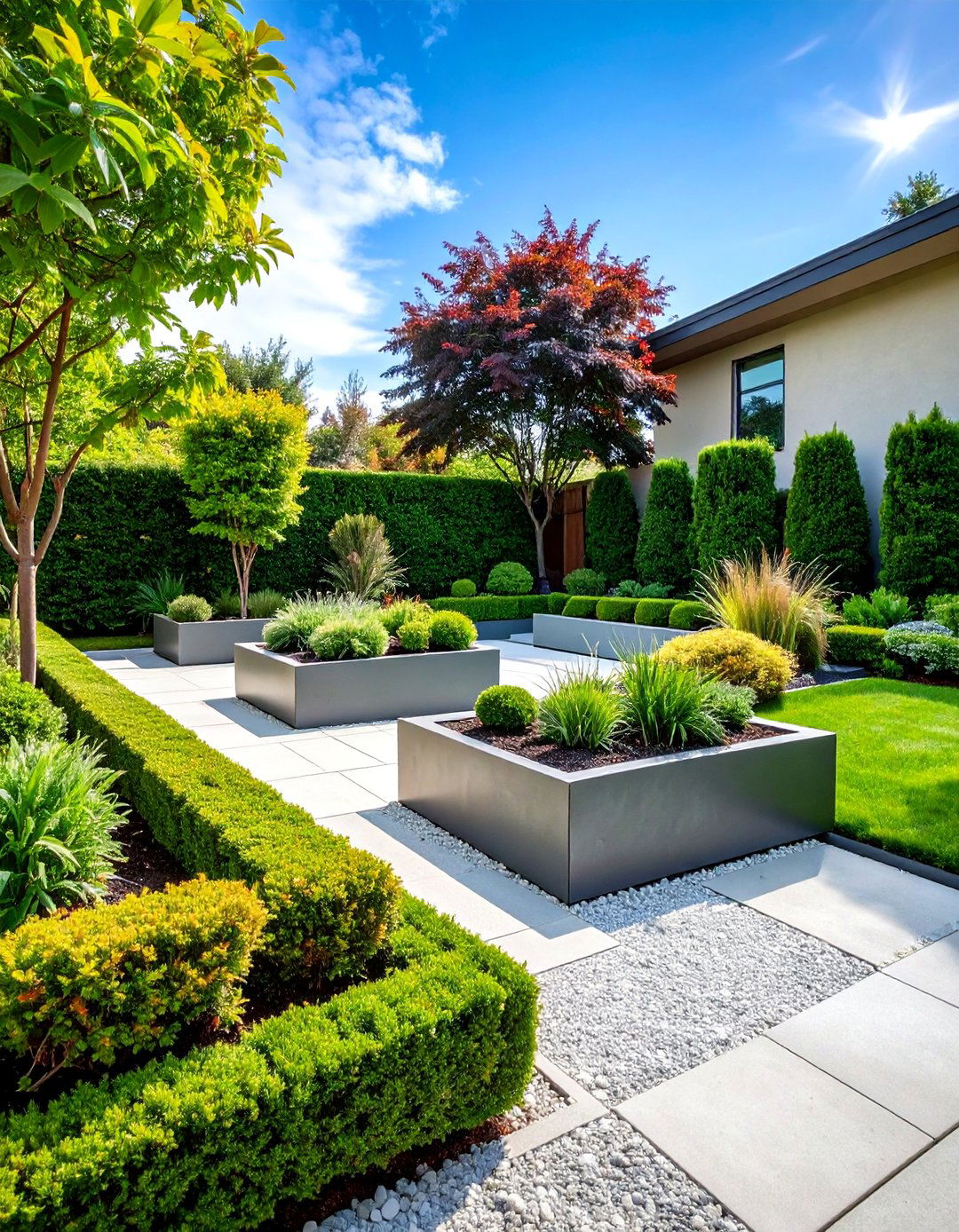
Contemporary outdoor design emphasizes simplicity through geometric forms, neutral color palettes, and carefully selected plantings. Rectangular raised planters contain architectural plants like boxwood hedges, ornamental grasses, and structural perennials. Concrete pathways create straight lines leading to designated seating areas with sleek outdoor furniture. Limited plant varieties maintain visual cohesion while reducing maintenance complexity. Gravel ground cover replaces traditional lawns, providing drainage and modern texture. Steel planters add industrial elements, while strategic lighting highlights key features after dark. This minimalist approach creates sophisticated outdoor rooms that complement contemporary home architecture, offering functional spaces for relaxation and entertainment while maintaining clean, uncluttered aesthetics that remain timeless and elegant.
3. Outdoor Living Room with Fire Feature and Entertainment Zone

Transform backyard space into an extension of indoor living with comfortable seating areas centered around warming fire features. Custom stone or brick fire pits become focal points surrounded by weather-resistant furniture including sectional seating, coffee tables, and accent pieces. Overhead pergolas or umbrellas provide shade and define intimate conversation areas. Built-in storage benches hold cushions and outdoor accessories. Landscape lighting creates ambiance for evening gatherings, while hardy plantings frame the entertainment zone with seasonal color and texture. Professional-grade outdoor kitchens or portable cooking stations expand functionality for hosting guests. This design creates seamless indoor-outdoor flow, encouraging year-round use of exterior spaces while providing comfortable settings for family gatherings and social entertainment in beautifully landscaped surroundings.
4. Vertical Garden Wall with Living Plant Display
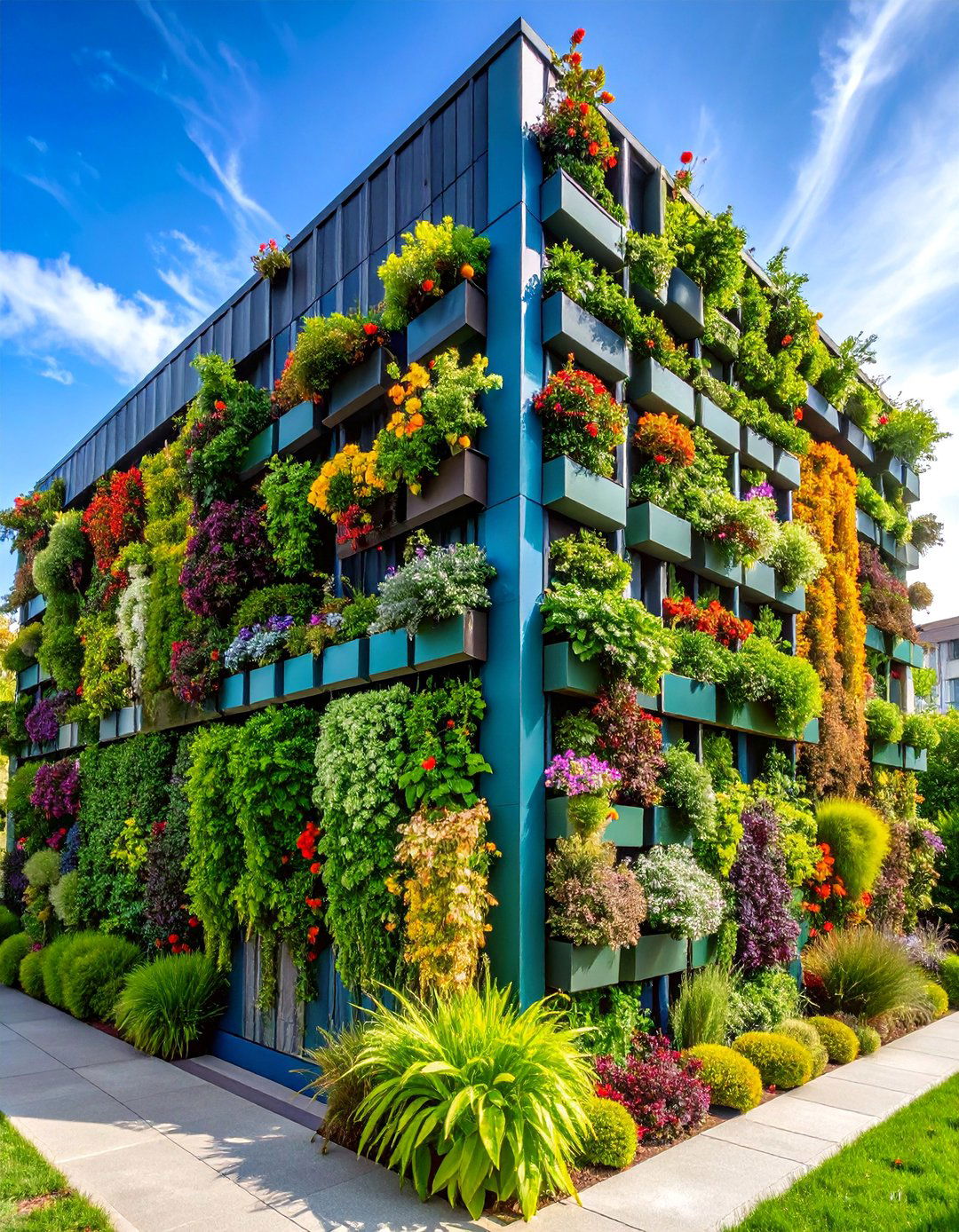
Maximize growing space while creating stunning visual impact through vertical gardening systems mounted on walls, fences, or freestanding structures. Modular planting panels hold diverse plant collections from herbs and vegetables to decorative flowers and trailing vines. Automated irrigation systems ensure consistent watering throughout the vertical structure. Mix textures and colors by combining different plant varieties at various heights and depths. These living walls provide privacy screening while producing fresh herbs and vegetables for kitchen use. Support structures range from simple trellis systems to sophisticated hydroponic installations. Vertical gardens suit small spaces, urban environments, or as accent features in larger landscapes. The installation transforms blank walls into productive, beautiful displays that change seasonally while providing ongoing harvests and natural air purification benefits.
5. Japanese Zen Garden with Meditation Space and Water Element
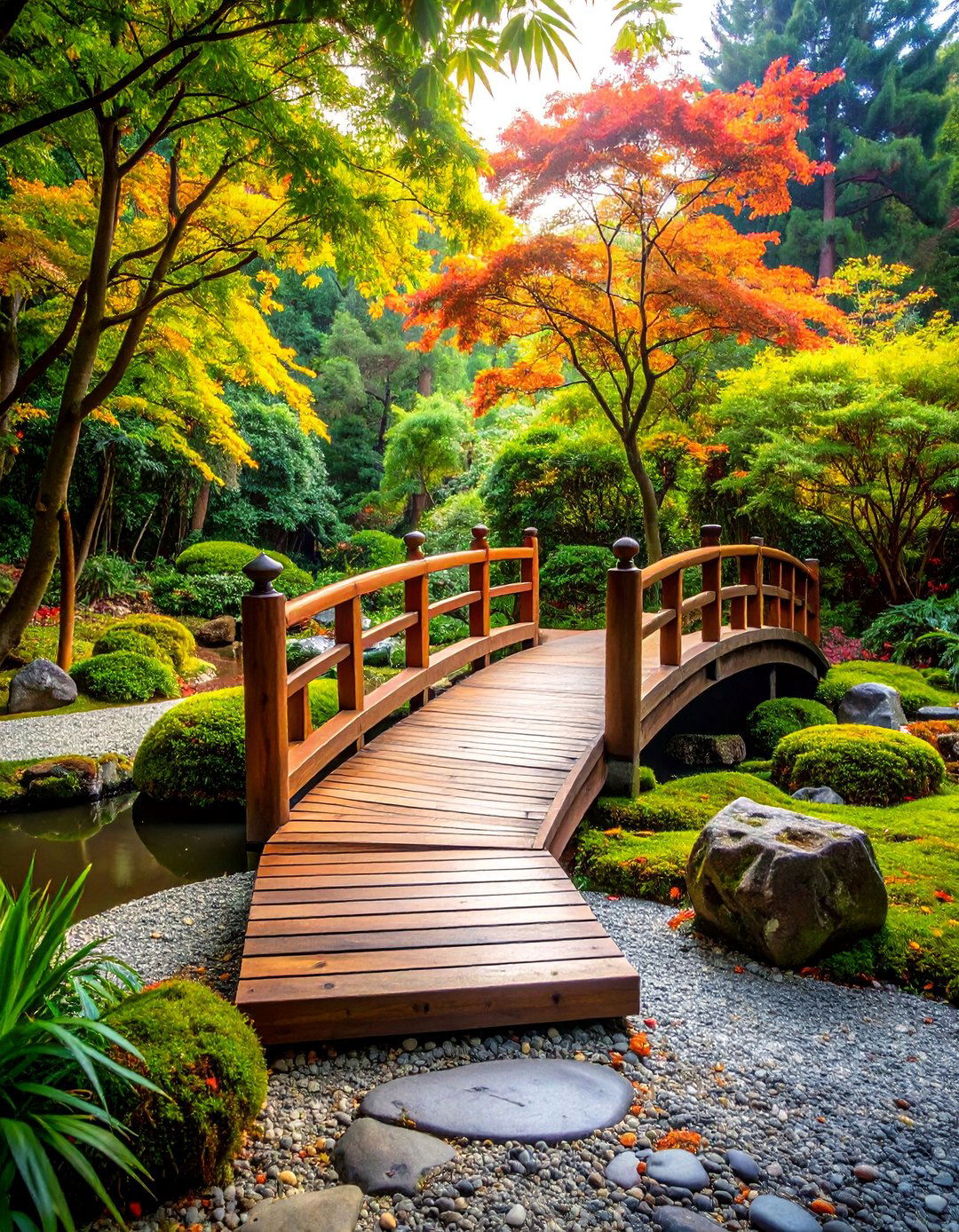
Create tranquil retreat spaces inspired by traditional Japanese garden principles emphasizing harmony, balance, and contemplation. Carefully raked gravel areas represent water flow, while strategically placed stones symbolize mountains and islands. Simple wooden bridges span dry creek beds filled with smooth river rocks. Bamboo fountains provide gentle water sounds that mask urban noise while encouraging mindful relaxation. Select plants include Japanese maples, bamboo groves, ferns, and moss ground cover that thrive in shaded conditions. Stone pathways lead to meditation seating areas positioned for optimal views of garden elements. This design philosophy promotes peace and reflection through carefully arranged natural materials, creating outdoor sanctuaries that support mental wellness while showcasing the beauty of restrained, purposeful landscape design.
6. Edible Landscape with Raised Beds and Herb Gardens
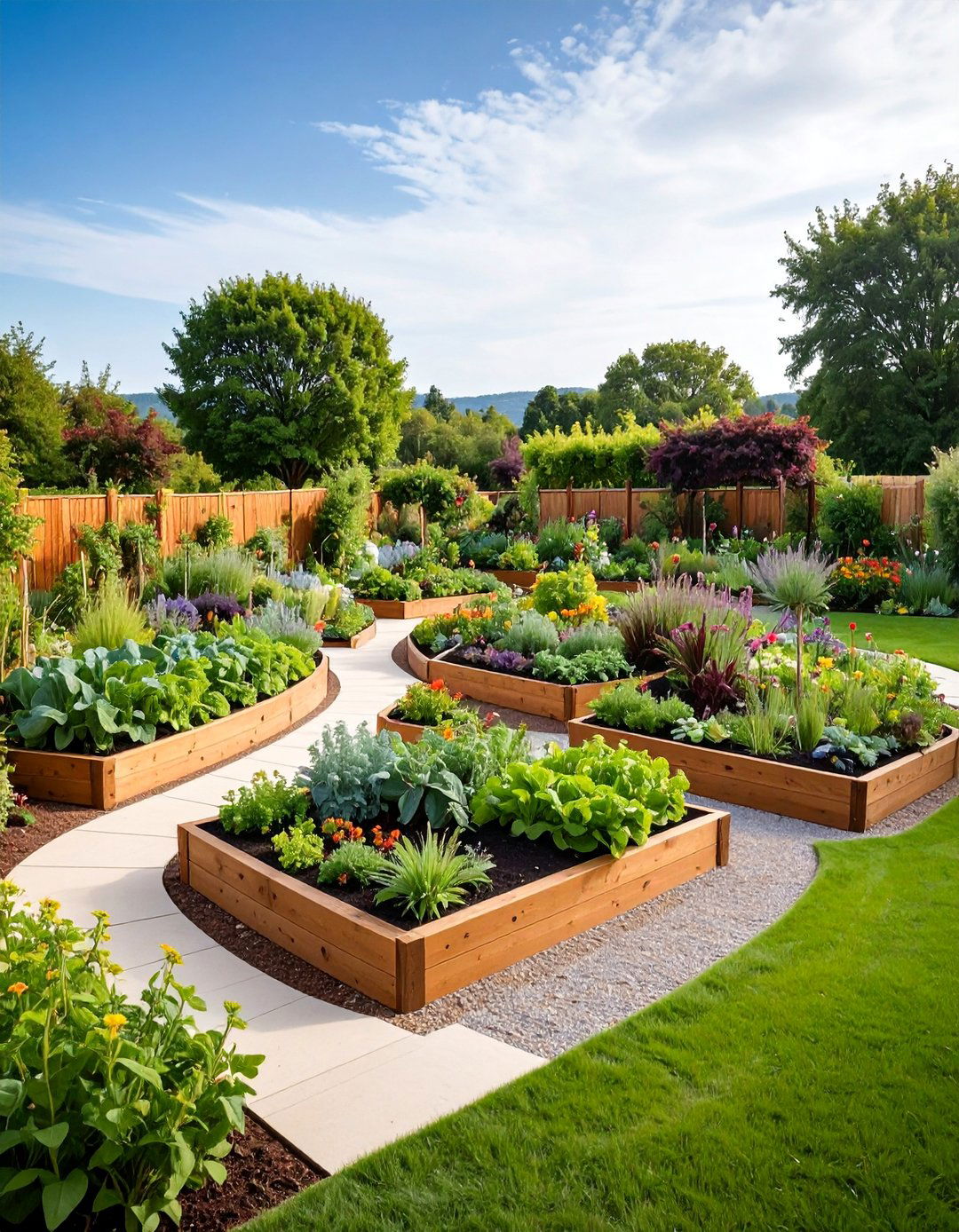
Combine ornamental beauty with functional food production through thoughtfully designed edible landscapes that integrate vegetables, herbs, and fruit trees throughout outdoor spaces. Raised garden beds constructed from cedar, stone, or metal create defined growing areas while improving soil drainage and accessibility. Fruit trees provide vertical elements and seasonal blooms before producing harvest crops. Herb spirals maximize growing space while creating microclimates for different plant requirements. Companion planting techniques pair vegetables with flowers that attract beneficial insects and improve growing conditions. Pathways between growing areas allow easy maintenance and harvesting access. This productive landscape approach proves that vegetable gardens can be beautiful focal points rather than hidden utility areas, creating sustainable food sources while maintaining attractive outdoor environments.
7. Mediterranean Courtyard with Drought-Resistant Plants
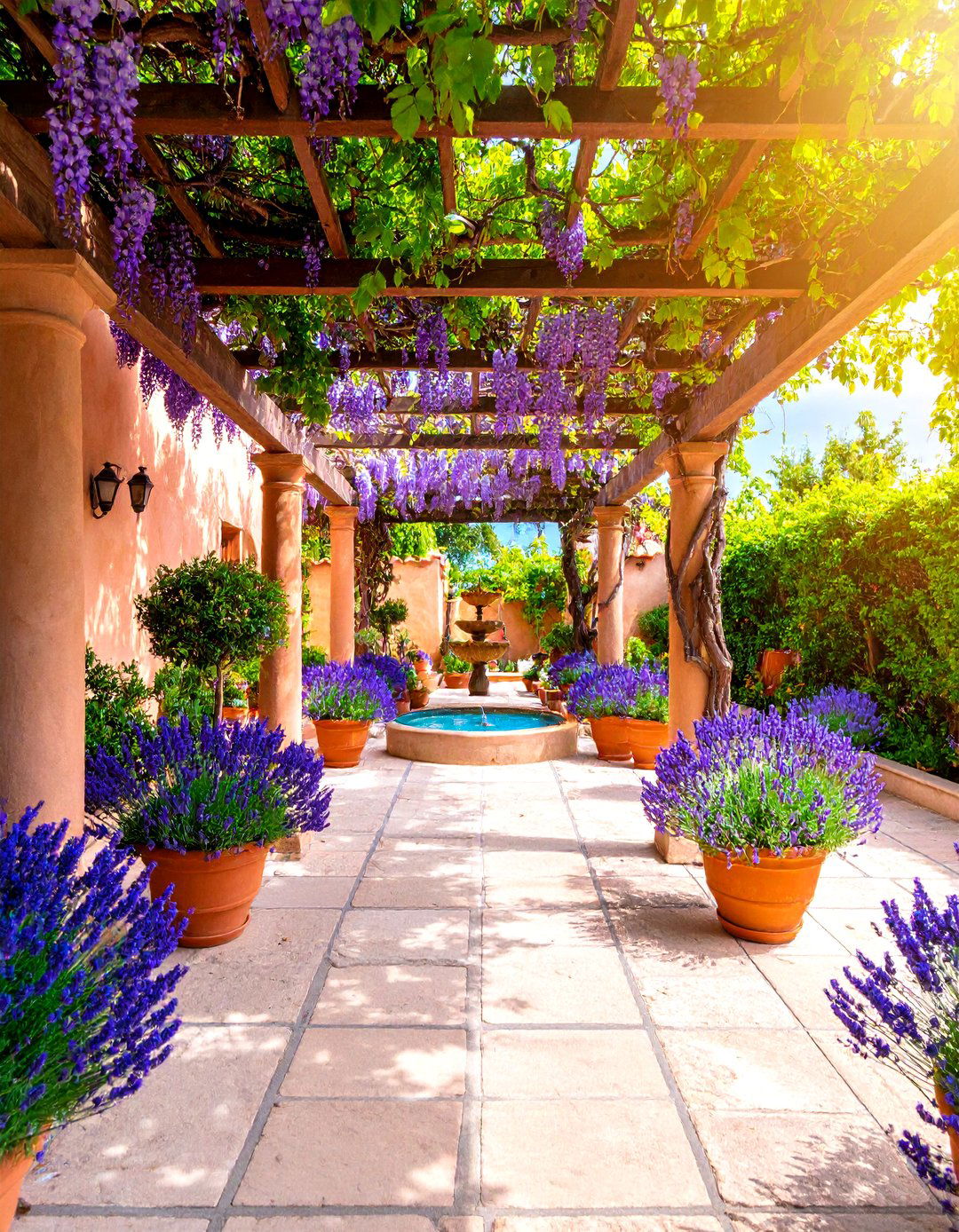
Embrace warm-climate aesthetics through Mediterranean-inspired landscapes featuring drought-tolerant plants, natural stone materials, and intimate courtyard settings. Terra cotta planters hold lavender, rosemary, olive trees, and succulents that thrive in dry conditions while providing aromatic herbs for cooking. Stone or tile pathways connect seating areas shaded by pergolas draped with grape vines or climbing roses. Water features like small fountains create cooling effects and pleasant sounds. Warm-toned hardscaping materials including limestone, sandstone, or brick complement the plant palette. This design style works well in arid climates or water-conscious landscapes, creating resort-like atmospheres that transport users to European coastal regions while requiring minimal irrigation and maintenance once established.
8. Rain Garden with Water Management and Native Wetland Plants
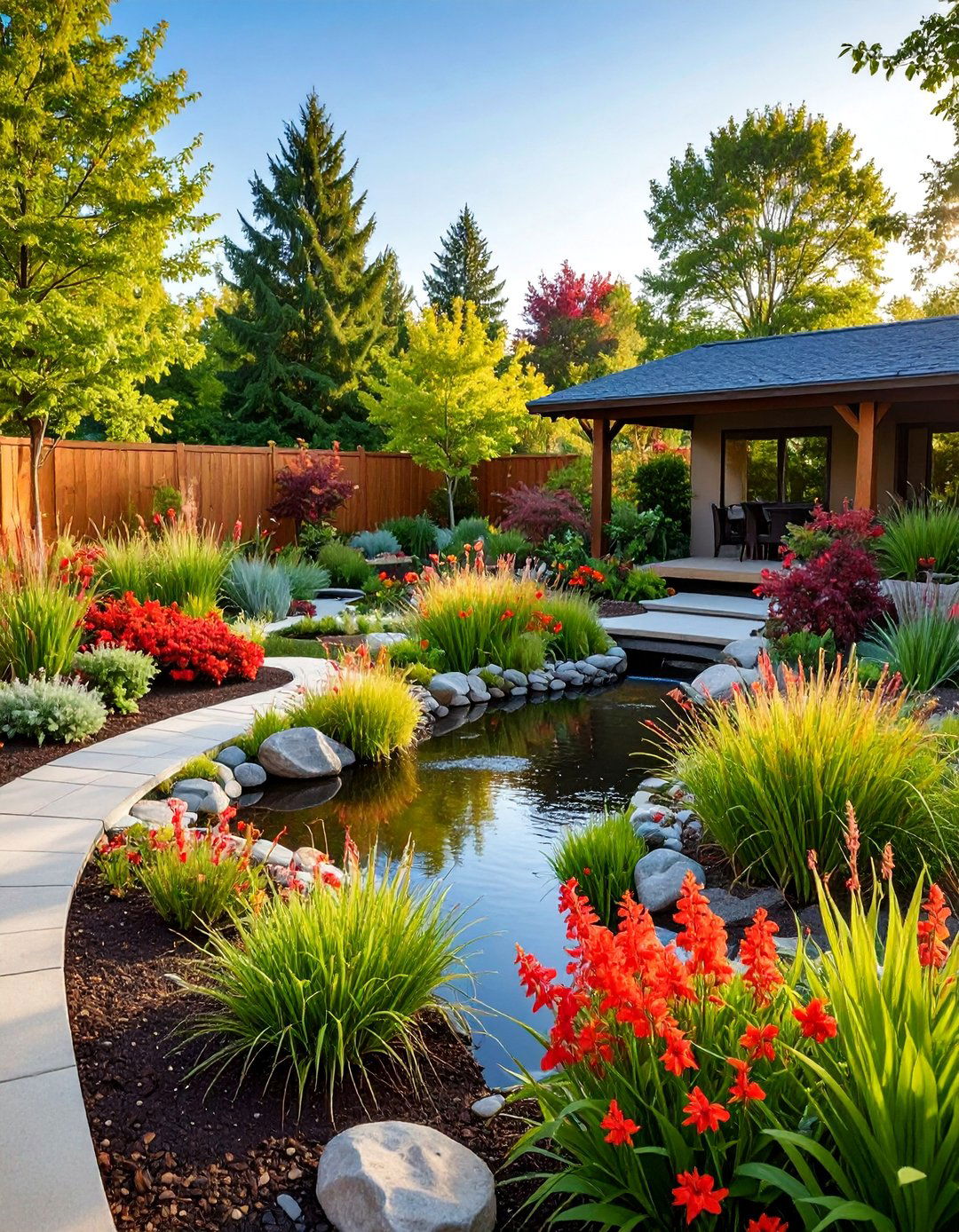
Design functional landscapes that manage stormwater runoff while creating beautiful planted areas that support local ecosystems. Rain gardens are shallow depressions that collect and filter water from roofs, driveways, and other impervious surfaces. Native wetland plants like cardinal flower, blue flag iris, and sedges thrive in these temporarily wet conditions while filtering pollutants from runoff water. Strategic placement captures water flow patterns, directing drainage toward planted areas rather than storm sewers. Mulched pathways provide access for maintenance while ornamental grasses and flowering perennials create seasonal interest. These environmentally beneficial landscapes reduce flooding risks, improve water quality, and support wildlife habitat while demonstrating responsible stewardship of natural resources through beautiful, functional garden design.
9. Contemporary Rock Garden with Succulent Display

Modern rock gardens showcase diverse succulent collections through artistic arrangements of stones, boulders, and drought-adapted plants. Various rock sizes and textures create visual interest while providing excellent drainage essential for succulent health. Plant selections include agaves, sedums, echeveria, and architectural cacti that offer sculptural forms and seasonal color changes. Decomposed granite or gravel pathways wind between planted areas, connecting viewing points and maintenance access routes. This low-water landscape style suits arid climates and water-conscious gardening while requiring minimal ongoing care. Strategic placement of larger specimen plants creates focal points, while mass plantings of smaller varieties provide textural ground cover. Contemporary rock gardens prove that xerophytic plants can create lush, colorful displays that challenge traditional notions of garden beauty.
10. Cottage Garden with Mixed Perennials and Flowering Shrubs
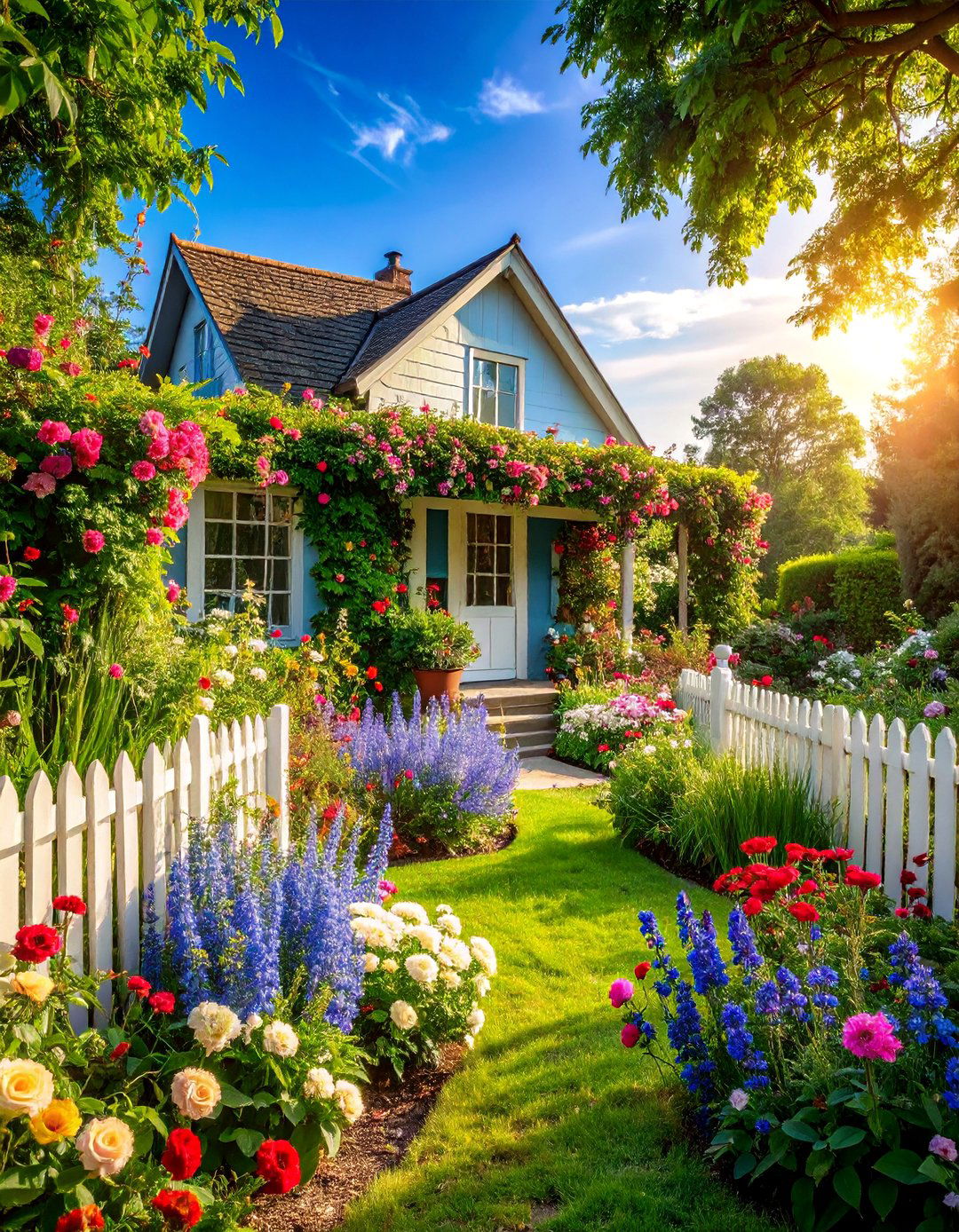
Traditional cottage garden style combines informal plantings of perennial flowers, herbs, and flowering shrubs to create abundant, romantic landscapes filled with color and fragrance. Plant selections include classic varieties like roses, peonies, delphiniums, and hollyhocks that bloom throughout growing seasons. Informal pathways wind through densely planted beds where flowers spill over edges and self-seed for natural abundance. White picket fences or rustic stone walls provide structure while supporting climbing roses and clematis vines. Herb plantings near kitchen access combine utility with beauty. This nostalgic garden style encourages wildlife through diverse flowering plants that attract butterflies and beneficial insects. Cottage gardens celebrate abundance over minimalism, creating welcoming outdoor spaces that feel established and loved while providing cutting flowers for indoor enjoyment.
11. Tropical Paradise with Palm Trees and Lush Foliage
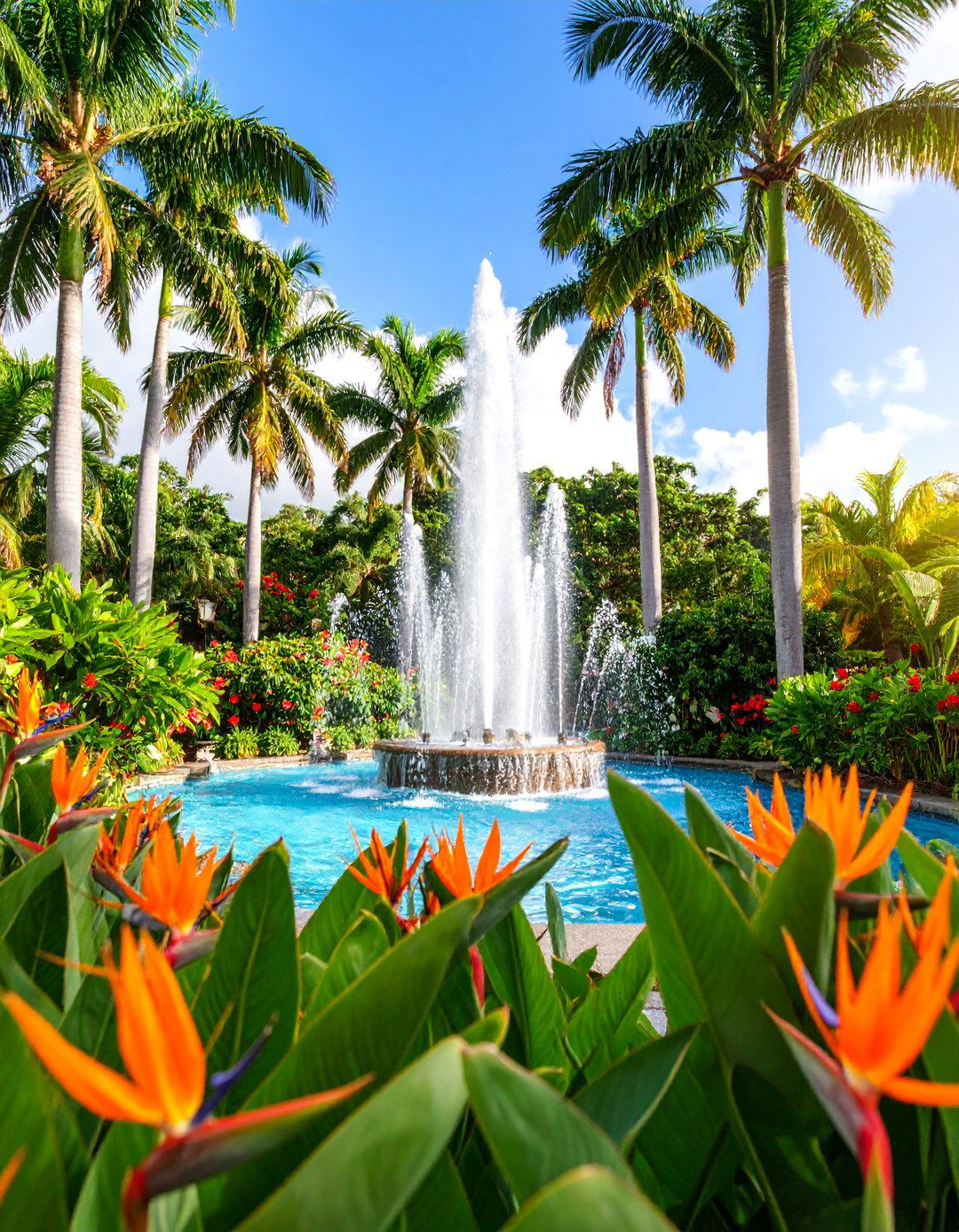
Transform outdoor spaces into exotic retreats through tropical landscaping featuring large-leafed plants, colorful flowers, and dramatic vertical elements. Palm varieties appropriate for your climate provide canopy structure, while understory plantings include hostas, ferns, bird of paradise, and hibiscus for tropical atmosphere. Water features like ponds or fountains increase humidity and create jungle-like ambiance. Warm-season annuals in bright colors add seasonal variety to the permanent tropical framework. Natural materials like bamboo, teak, and stone create pathways and seating areas that complement lush plantings. Even temperate climates can achieve tropical effects through careful plant selection and microclimate creation. This immersive landscape style creates vacation-like environments at home, providing year-round escape from ordinary surroundings through dramatic, exotic plant displays.
12. Prairie Meadow Garden with Native Grasses and Wildflowers
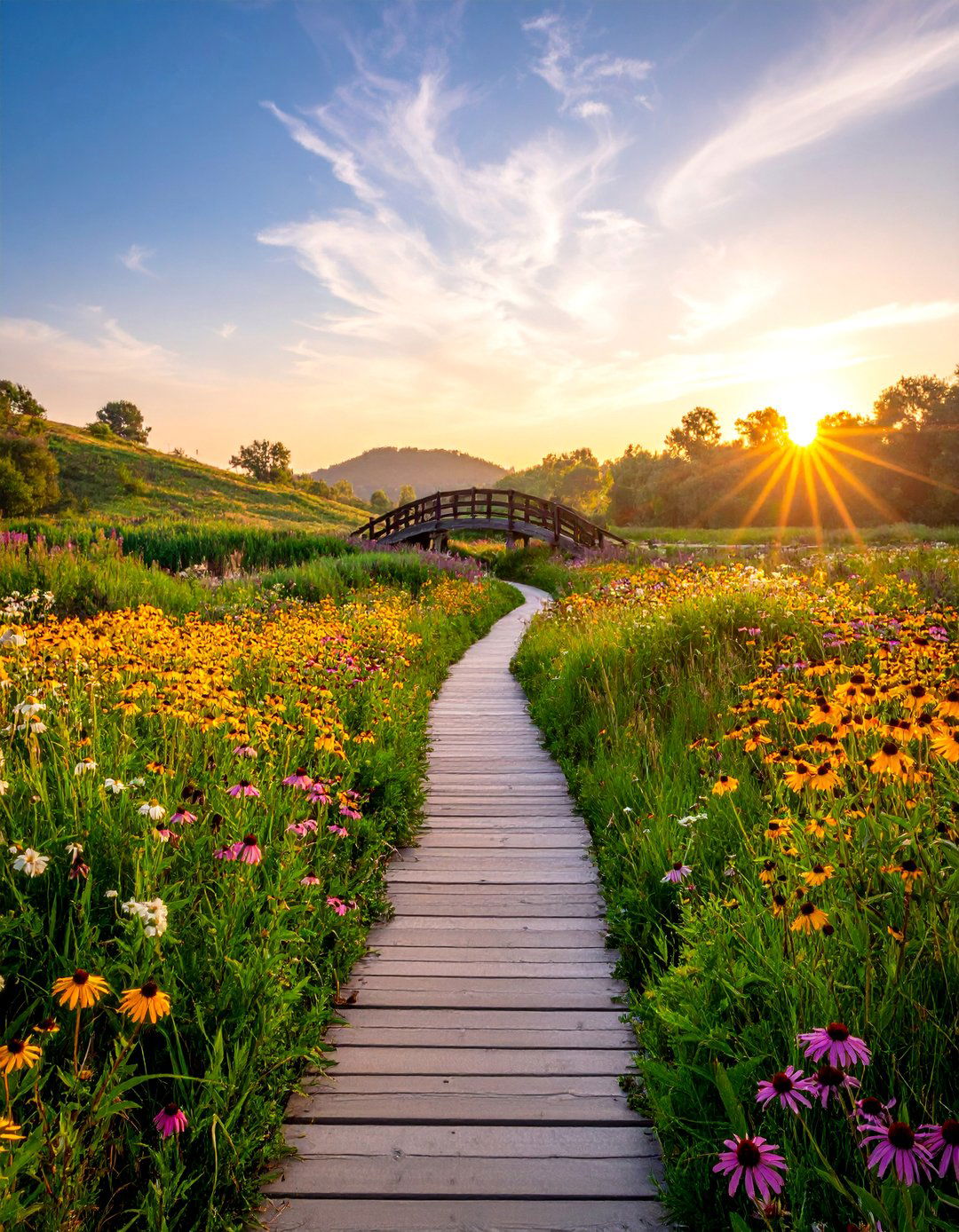
Celebrate regional ecosystems through prairie-inspired landscapes that recreate natural grassland communities with native grasses and wildflowers. Tall grass varieties like big bluestem and switch grass provide structure and winter interest, while native wildflowers including black-eyed Susan, purple coneflower, and wild bergamot add seasonal color. This naturalistic approach requires initial establishment period but becomes self-sustaining with minimal maintenance once established. Prairie gardens support diverse wildlife including birds, butterflies, and beneficial insects while reducing lawn maintenance requirements. Strategic mowing paths create access through taller plantings while maintaining wild appearance. These ecosystems demonstrate environmental stewardship while creating dynamic landscapes that change dramatically through seasons, offering educational opportunities about native plant communities and sustainable gardening practices that support regional biodiversity.
13. Modern Water Feature with Reflecting Pool and Lighting
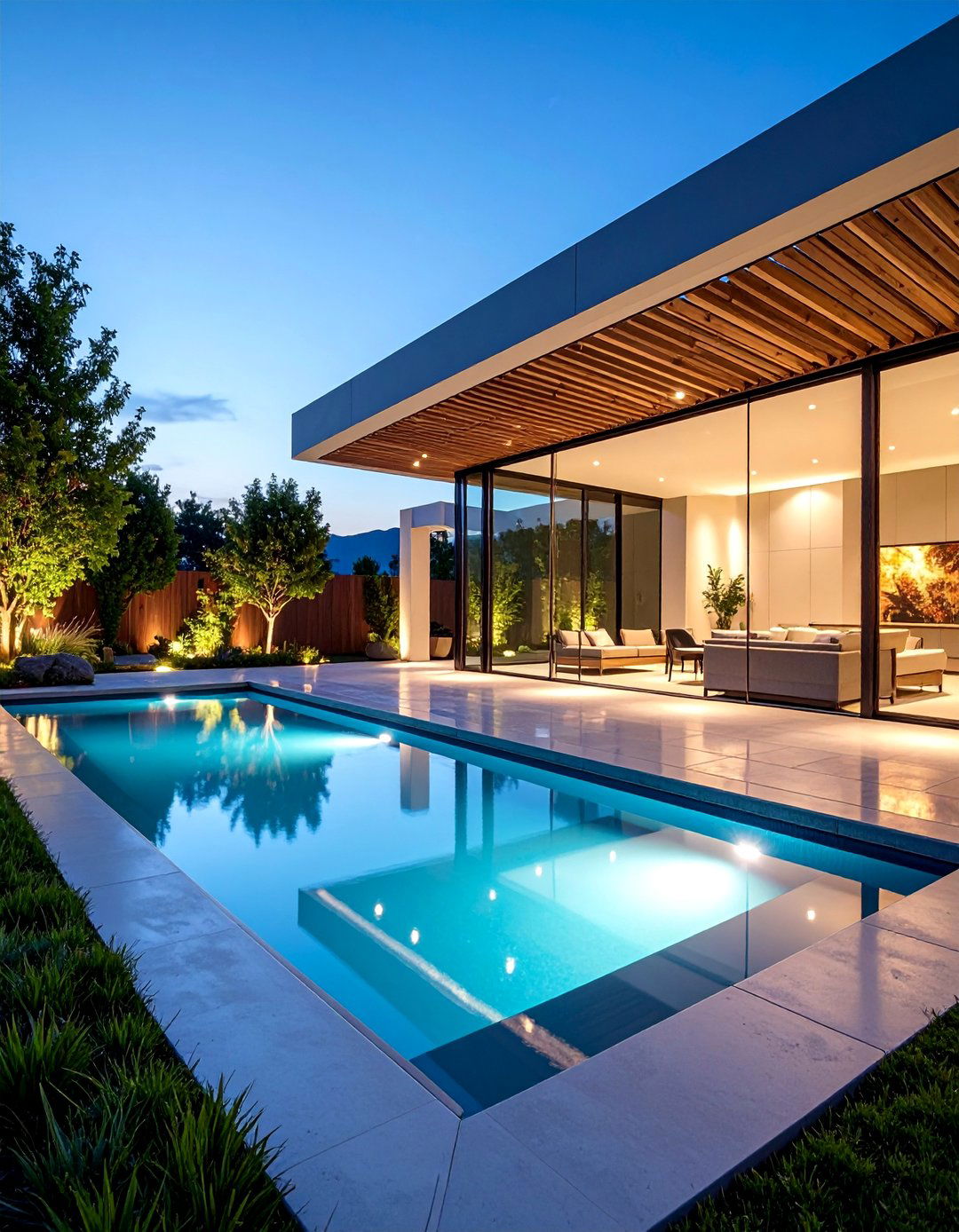
Contemporary water features serve as dramatic focal points through sleek designs that incorporate reflective surfaces, geometric forms, and integrated lighting systems. Rectangular or linear reflecting pools create mirror effects that double visual impact of surrounding plantings and architectural elements. Fountain elements add movement and sound while maintaining clean aesthetic lines. LED lighting systems illuminate water features after dark, creating stunning nighttime displays. Surrounding plantings remain minimal and architectural to complement rather than compete with water elements. Materials like steel, concrete, or natural stone provide durable, weather-resistant construction. These sophisticated installations require professional installation but create resort-quality environments that significantly enhance property values while providing cooling effects and meditative qualities that transform ordinary outdoor spaces into extraordinary landscape experiences.
14. Pollinator Garden with Butterfly-Attracting Native Plants

Support declining pollinator populations through dedicated garden spaces designed specifically for butterflies, bees, and beneficial insects. Plant selections focus on native varieties that provide nectar sources throughout growing seasons, including milkweed for monarch butterflies, bee balm, asters, and native flowering trees. Diverse bloom times ensure continuous food sources from early spring through late fall. Shallow water sources and puddling areas provide drinking opportunities for visiting insects. Avoid pesticide use to maintain healthy insect populations. Include host plants where butterflies can lay eggs and caterpillars can develop. These conservation-minded landscapes demonstrate environmental responsibility while creating dynamic outdoor spaces filled with colorful flowers and visiting wildlife. Pollinator gardens educate families about ecosystem connections while providing ongoing entertainment through butterfly watching and seasonal garden changes that support essential ecological processes.
15. Shade Garden Sanctuary with Woodland Plants
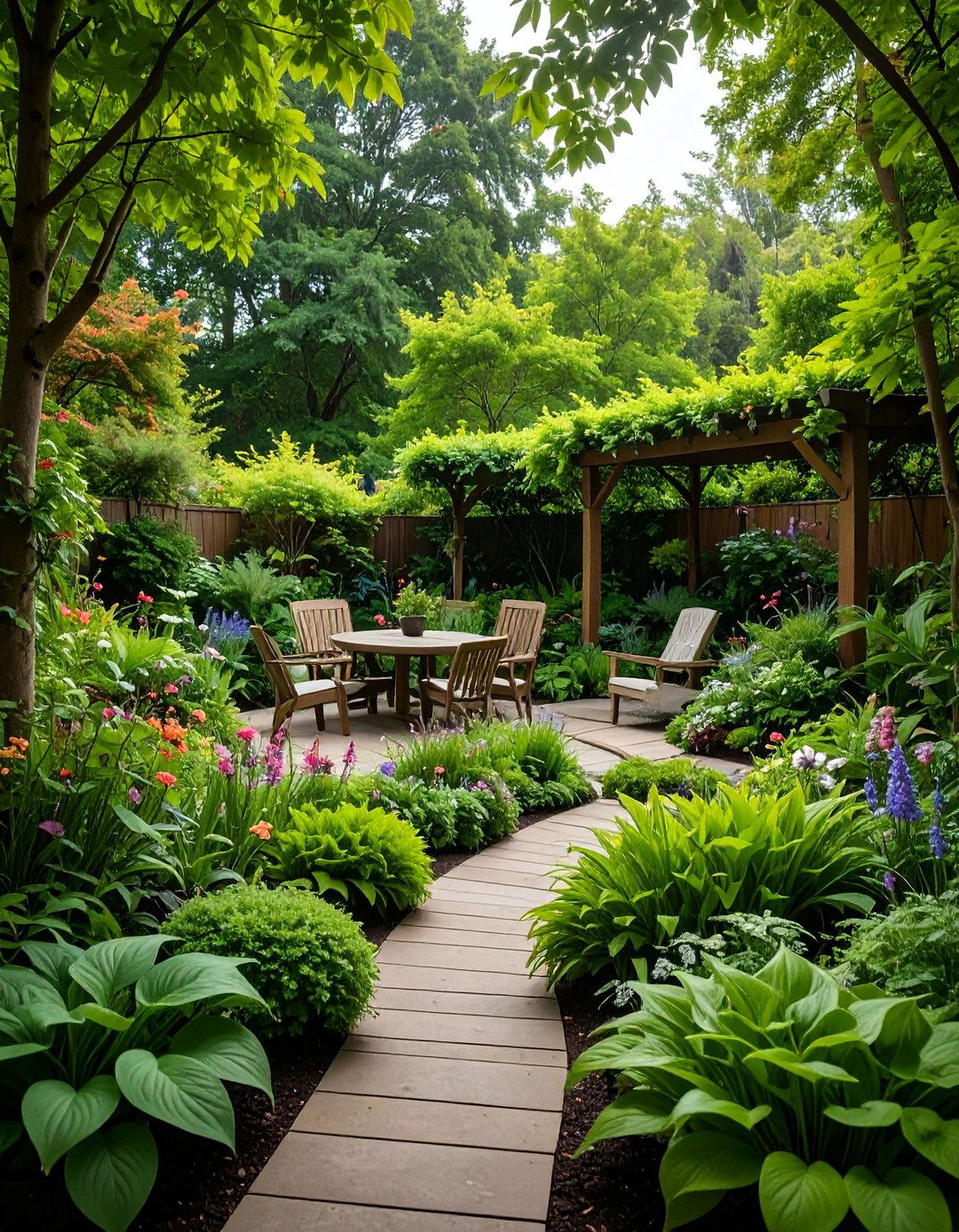
Transform challenging low-light areas into beautiful retreat spaces through carefully selected shade-tolerant plants that thrive without direct sunlight. Hostas provide dramatic foliage in multiple sizes and colors, while ferns add delicate texture and natural woodland character. Flowering shade plants like astilbe, coral bells, and caladiums provide seasonal color without requiring full sun exposure. Natural pathways wind through planted areas, connecting seating spots positioned for optimal garden views. Mulched surfaces suppress weeds while retaining soil moisture essential for shade plant health. These peaceful environments offer cool respites during hot weather while utilizing spaces that might otherwise remain unused. Shade gardens prove that sun-challenged areas can become landscape assets through thoughtful plant selection and design that celebrates the unique beauty of woodland ecosystems.
16. Desert Landscape with Cacti and Xerophytic Plants
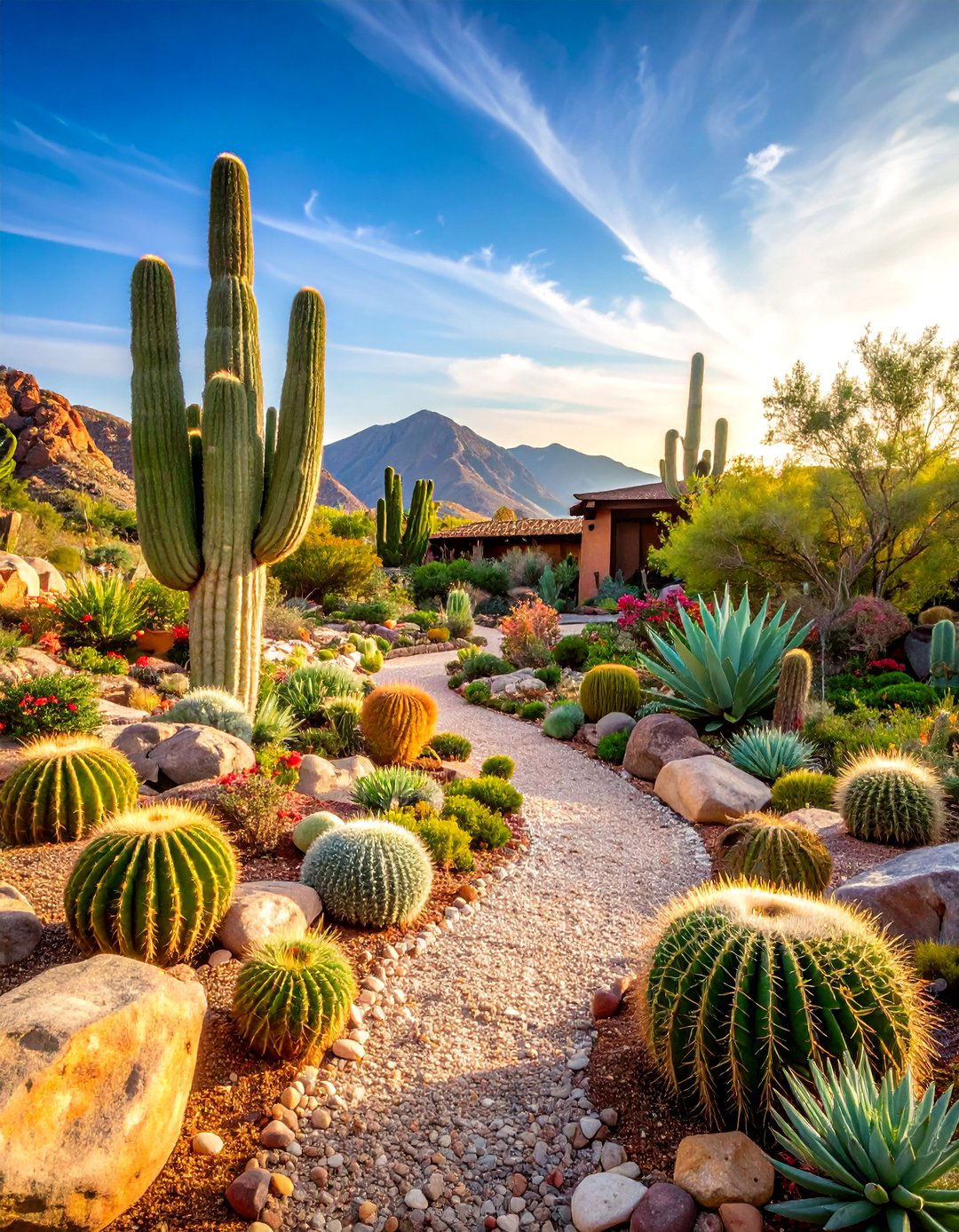
Embrace arid climate conditions through desert-inspired landscapes featuring cacti, succulents, and other water-efficient plants adapted to hot, dry conditions. Large specimen cacti like barrel cactus or prickly pear create dramatic focal points, while smaller varieties provide textural ground cover. Decomposed granite or gravel surfaces eliminate water-hungry lawns while providing excellent drainage. Natural boulder placement creates visual interest and wildlife habitat. Desert plants offer surprising variety in forms, colors, and seasonal blooms that challenge misconceptions about arid landscapes. This water-wise approach suits southwestern climates while demonstrating environmental responsibility through plant choices that thrive without supplemental irrigation. Strategic shade structures provide human comfort while protecting more sensitive plant varieties. Desert landscapes celebrate the unique beauty of arid ecosystems while creating low-maintenance outdoor environments.
17. Front Yard Transformation with Curb Appeal Focus

Replace traditional lawn-dominant front yards with dynamic landscapes that showcase personality while enhancing property values and neighborhood aesthetics. Layered plantings create depth through varying heights, textures, and seasonal colors that provide year-round interest. Foundation plantings complement home architecture while screening utility areas and creating privacy. Decorative pathways guide visitors toward entrances while defining planted areas. Landscape lighting highlights key features and provides security illumination. Container plantings allow seasonal variety and color changes near entryways. This comprehensive approach transforms uninspiring front spaces into welcoming landscapes that reflect homeowner personality while contributing positively to neighborhood character. Strategic plant placement frames architectural features while seasonal displays maintain ongoing visual interest that encourages community connections and pride in outdoor environments.
18. Outdoor Kitchen Garden with Herb and Vegetable Integration

Combine culinary gardens with outdoor cooking spaces for seamless farm-to-table experiences in home landscapes. Raised beds positioned near outdoor kitchens provide easy access for harvesting fresh ingredients during meal preparation. Herb gardens feature culinary varieties like basil, rosemary, thyme, and oregano planted in dedicated spaces or integrated throughout landscape beds. Fruit trees and berry bushes add vertical elements while producing seasonal harvests. Compost areas support sustainable gardening practices by recycling kitchen scraps into valuable soil amendments. Professional outdoor kitchen installations include storage for gardening tools and harvested produce. This functional approach demonstrates self-sufficiency while creating beautiful productive landscapes that encourage healthy eating and outdoor entertainment. The integration of growing and cooking spaces supports sustainable lifestyles while providing ongoing harvests and landscape beauty.
19. Privacy Screen Landscape with Natural Barriers

Create secluded outdoor environments through strategic plantings that provide natural privacy while maintaining attractive landscape aesthetics. Evergreen trees and shrubs offer year-round screening from neighboring properties or street views. Layered plantings combine different heights and textures for visual interest while maximizing privacy benefits. Fast-growing varieties like bamboo, arborvitae, or privet create quick screening solutions. Flowering shrubs add seasonal color while maintaining functional barriers. Natural fencing materials like cedar or bamboo complement planted screens. These living walls provide environmental benefits including air purification, noise reduction, and wildlife habitat while creating intimate outdoor spaces. Strategic placement considers mature plant sizes and growing conditions to ensure long-term success. Privacy landscapes prove that functional needs can be addressed through beautiful, natural solutions that enhance rather than detract from overall garden design.
20. Rock Waterfall Feature with Natural Stone Landscaping
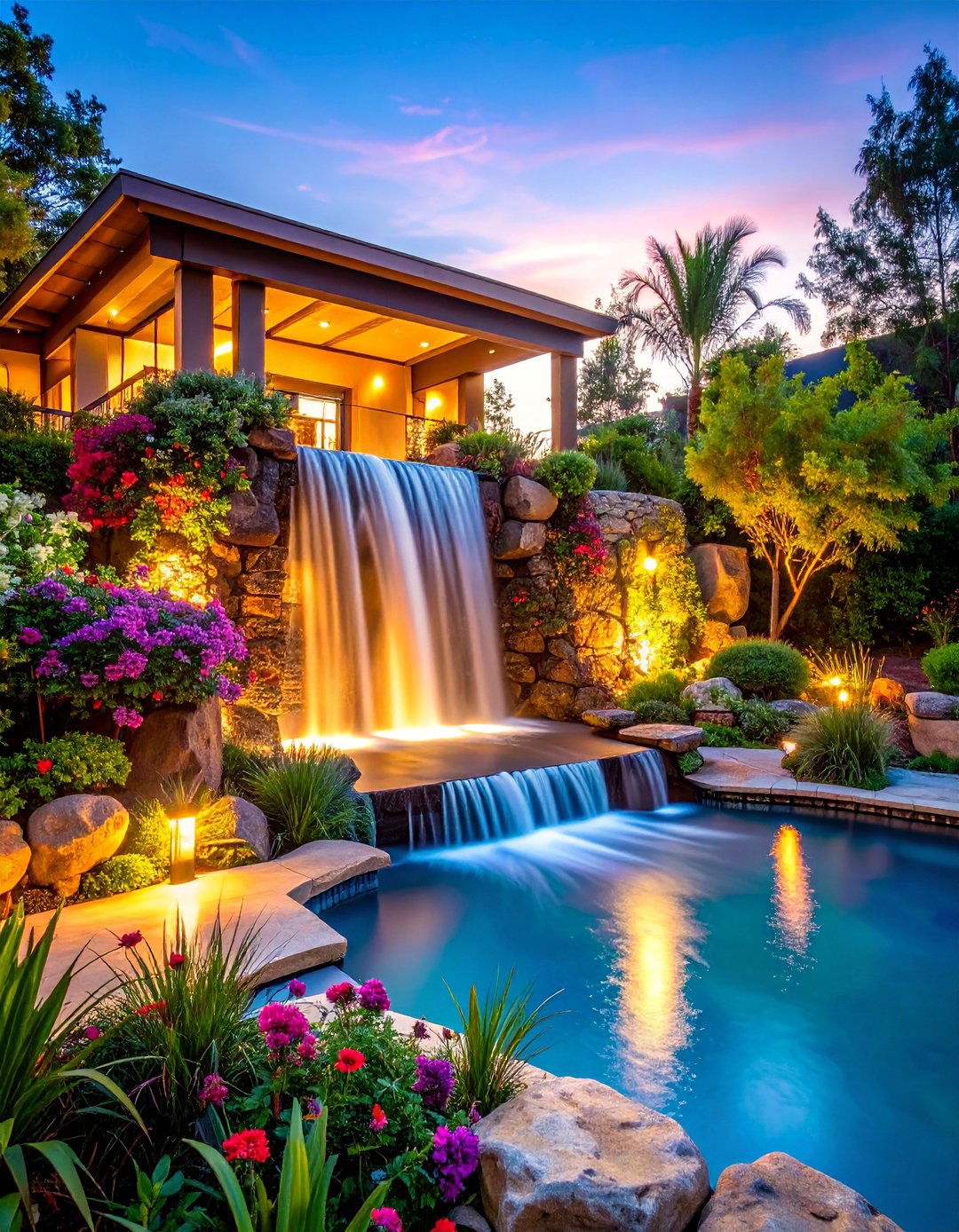
Dramatic water features combining natural stone construction with cascading water elements create spectacular focal points that transform ordinary outdoor spaces. Professional installation ensures proper water circulation, filtration, and electrical systems for reliable operation. Surrounding plantings include moisture-loving varieties that thrive near water features while maintaining natural appearances. Stone selection considers local materials and architectural compatibility for cohesive landscape design. Pool areas at waterfall bases provide fish habitat and reflective water surfaces. Landscape lighting illuminates falling water for dramatic nighttime effects. These substantial installations require significant investment but create resort-quality environments that significantly increase property values. Natural stone construction ensures durability and weather resistance while providing habitat for beneficial wildlife. Waterfall features demonstrate landscape engineering capabilities while creating meditation-worthy outdoor environments that provide ongoing enjoyment and impressive entertainment spaces.
21. Container Garden Display with Seasonal Plant Rotation
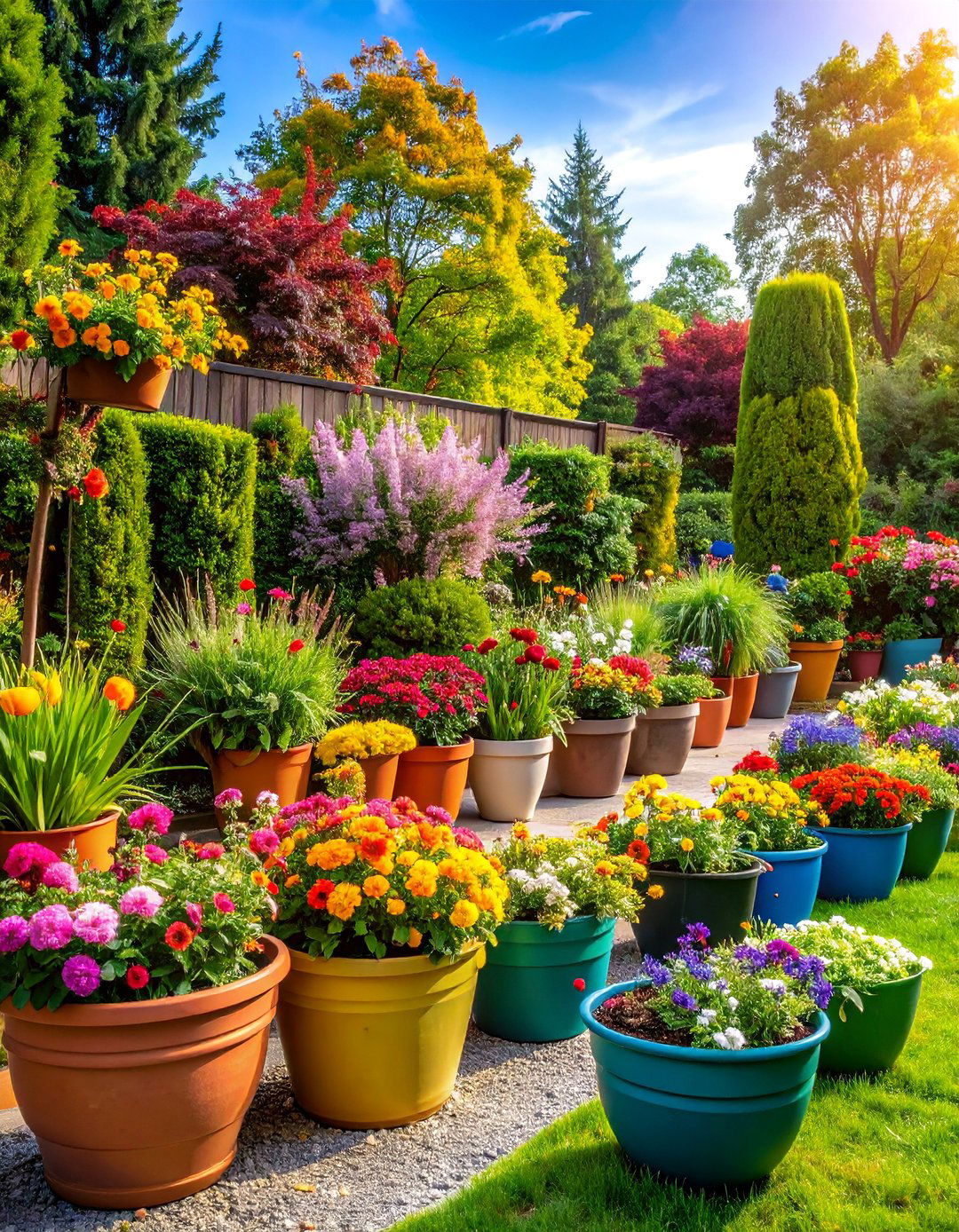
Maximize landscape flexibility through strategic container gardening that allows seasonal plant changes, mobility, and diverse growing conditions within single outdoor spaces. Large planters accommodate trees and shrubs for permanent structure, while smaller containers provide seasonal color through annuals and perennials. Groupings of various sized containers create layered displays with visual depth and interest. This approach suits rental properties, small spaces, or areas with challenging soil conditions. Container materials range from classic terra cotta to contemporary metals and composite materials that complement different design styles. Seasonal rotation maintains ongoing interest through spring bulbs, summer annuals, fall decorative elements, and winter evergreen displays. Strategic placement creates focal points, defines seating areas, and provides flexibility for landscape changes. Container gardens demonstrate that beautiful landscapes can be created without permanent installations while providing gardening opportunities in challenging spaces.
22. Moonlight Garden with White Flowers and Evening Fragrance

Design enchanting nighttime landscapes through careful selection of white-flowering plants and evening-fragrant varieties that come alive after dark. White flowers like moonflower, four o'clocks, and white roses reflect moonlight and artificial lighting for dramatic nighttime visibility. Evening-blooming plants including night-blooming cereus and evening primrose provide unique after-dark displays. Fragrant varieties like jasmine, gardenia, and tuberose release intensive scents during evening hours. Landscape lighting systems highlight white blooms while creating magical ambiance for evening entertaining and relaxation. Silver-leafed plants like dusty miller and lamb's ear provide textural contrast while maintaining the light color theme. These specialized gardens extend outdoor enjoyment into evening hours while creating romantic, sophisticated environments that demonstrate advanced garden design concepts through thoughtful plant selection and strategic lighting integration.
23. Xeriscape Design with Water-Wise Plant Selection
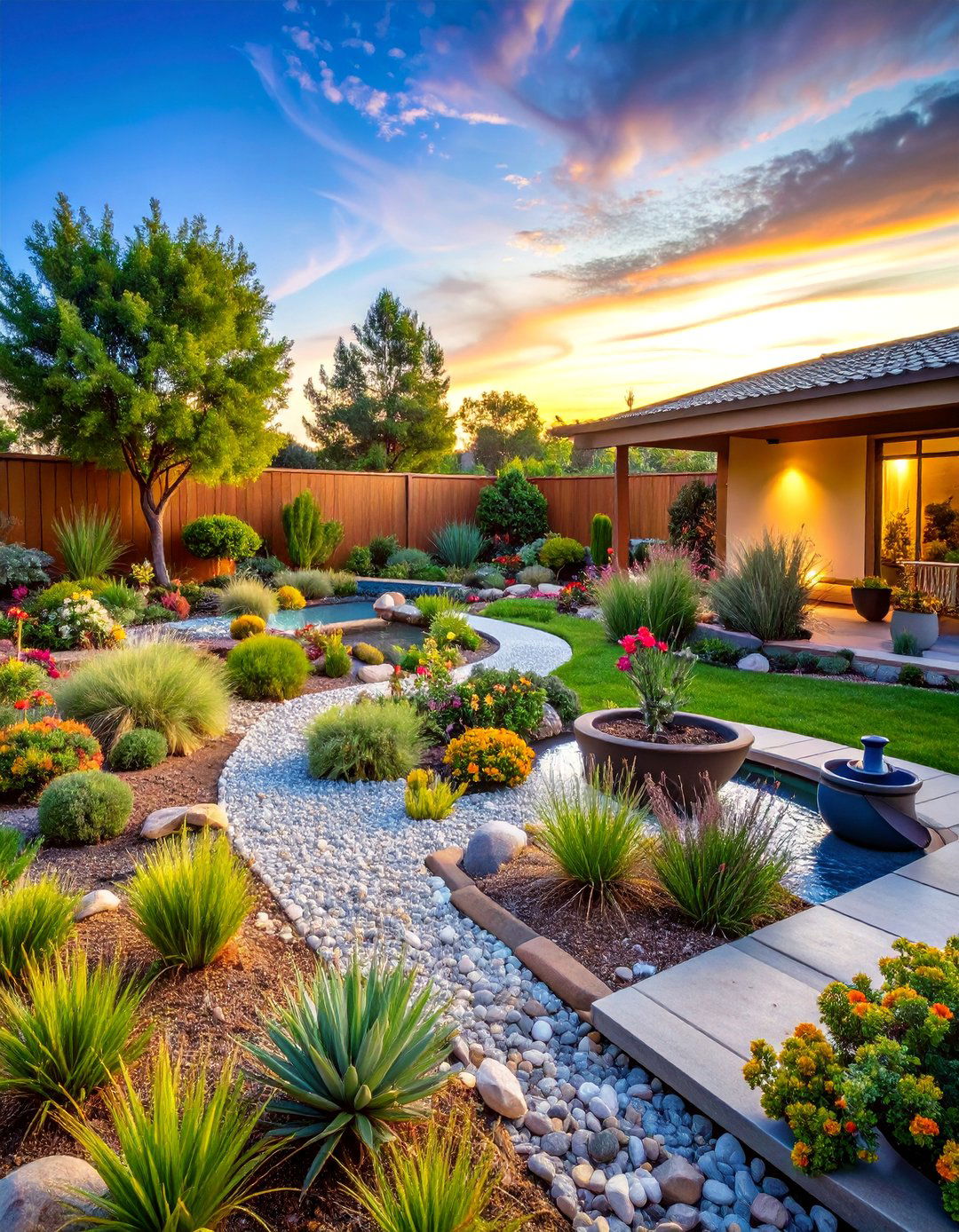
Develop comprehensive water-conservation landscapes through xeriscaping principles that maintain beauty while dramatically reducing irrigation requirements. Plant selections emphasize native and adapted species that thrive in local rainfall patterns without supplemental watering once established. Efficient irrigation systems like drip technology target root zones while minimizing water waste. Mulching strategies conserve soil moisture while suppressing weed growth. Hardscaping elements including pathways, patios, and decorative rocks reduce planted areas requiring water. Soil amendments improve drainage and water retention capabilities. This environmentally responsible approach creates sustainable landscapes that maintain beauty during drought conditions while reducing maintenance requirements and utility costs. Xeriscaping proves that water-wise gardening can produce lush, colorful displays that challenge traditional high-water landscape assumptions while supporting environmental conservation through responsible resource use.
24. Sports and Recreation Landscape with Activity Zones

Design active outdoor environments that accommodate sports, recreation, and family activities while maintaining attractive landscape aesthetics. Designated areas for basketball, volleyball, or badminton provide exercise opportunities within residential settings. Game spaces like bocce ball courts or horseshoe pits create entertainment options for all ages. Open lawn areas accommodate informal sports and children's play activities. Strategic fencing and netting contain sports activities while protecting planted areas and neighboring properties. Spectator seating and shade structures support extended outdoor recreation time. Storage solutions hide sports equipment while maintaining landscape visual appeal. These active landscapes promote healthy lifestyles while providing entertainment options that encourage outdoor family time. Thoughtful design balances functional recreation needs with aesthetic landscape requirements, creating environments that support both active and passive outdoor enjoyment through comprehensive recreational landscape planning.
25. Four-Season Interest Garden with Year-Round Plant Display

Create landscapes that provide visual interest throughout all seasons by carefully selecting plants with different bloom times, foliage colors, bark textures, and structural forms. Spring displays feature bulbs and early-flowering trees, while summer showcases perennial blooms and lush foliage. Fall highlights include ornamental grasses, late-blooming perennials, and trees with dramatic autumn color changes. Winter interest comes from evergreen plants, interesting bark textures, persistent berries, and structural plant forms that remain attractive after leaves fall. Seasonal container displays can be rotated to maintain ongoing color and interest. This comprehensive approach ensures outdoor spaces remain beautiful and engaging throughout the year rather than having brief peak seasons followed by dormant periods. Four-season gardens demonstrate advanced planning skills while providing ongoing landscape enjoyment that justifies investment in outdoor living spaces through consistent beauty and interest.
Conclusion:
These 25 landscaping ideas demonstrate the endless possibilities for creating beautiful, functional outdoor spaces that reflect personal style while addressing practical needs like sustainability, maintenance, and climate adaptation. Whether pursuing modern minimalism, cottage garden abundance, or water-wise xeriscaping, successful landscapes begin with thoughtful planning that considers site conditions, lifestyle requirements, and long-term goals. Professional consultation can help navigate complex installations while DIY approaches work well for smaller projects. The key lies in selecting appropriate plants for your climate and conditions while creating cohesive designs that enhance both property values and outdoor living enjoyment for years to come.


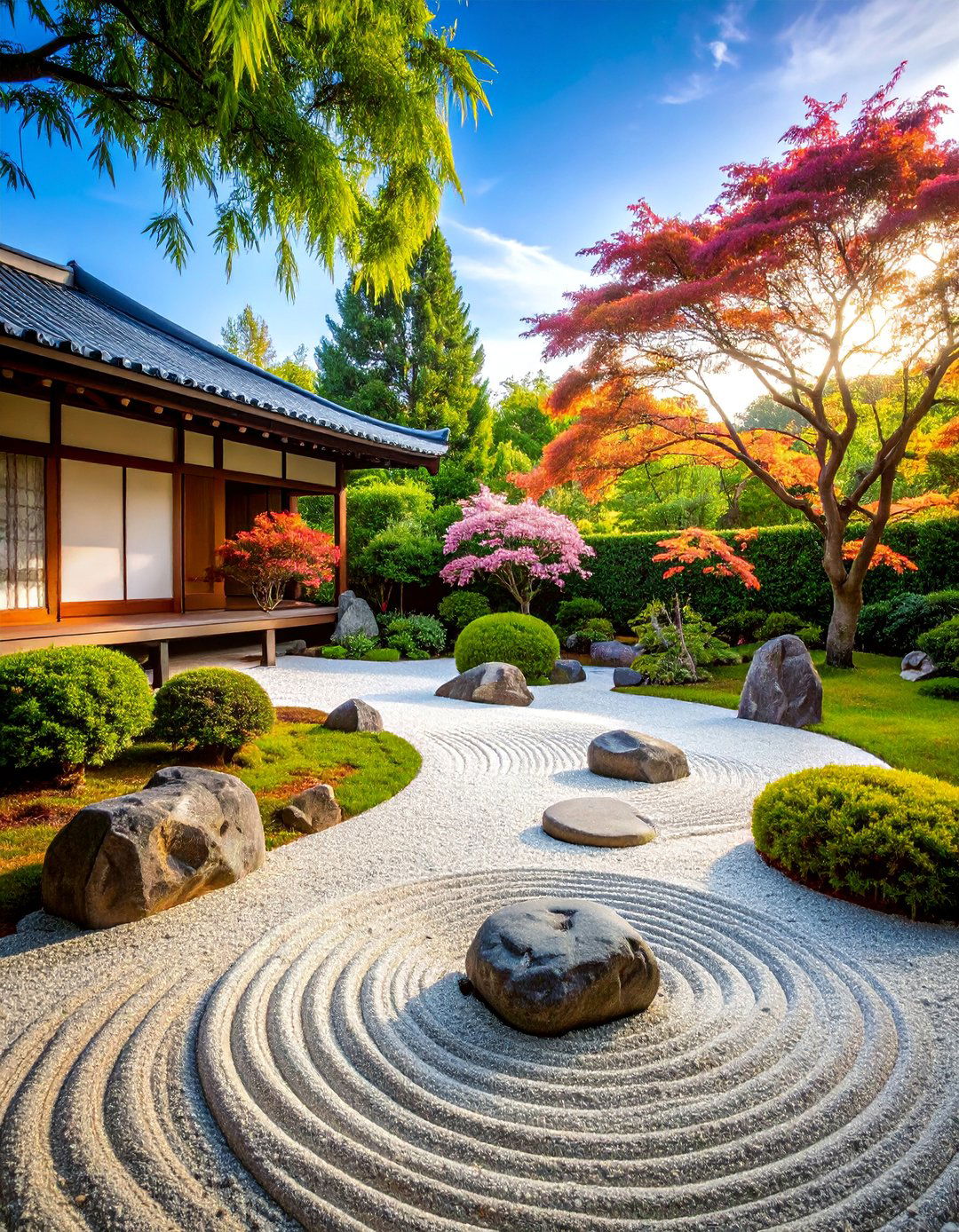

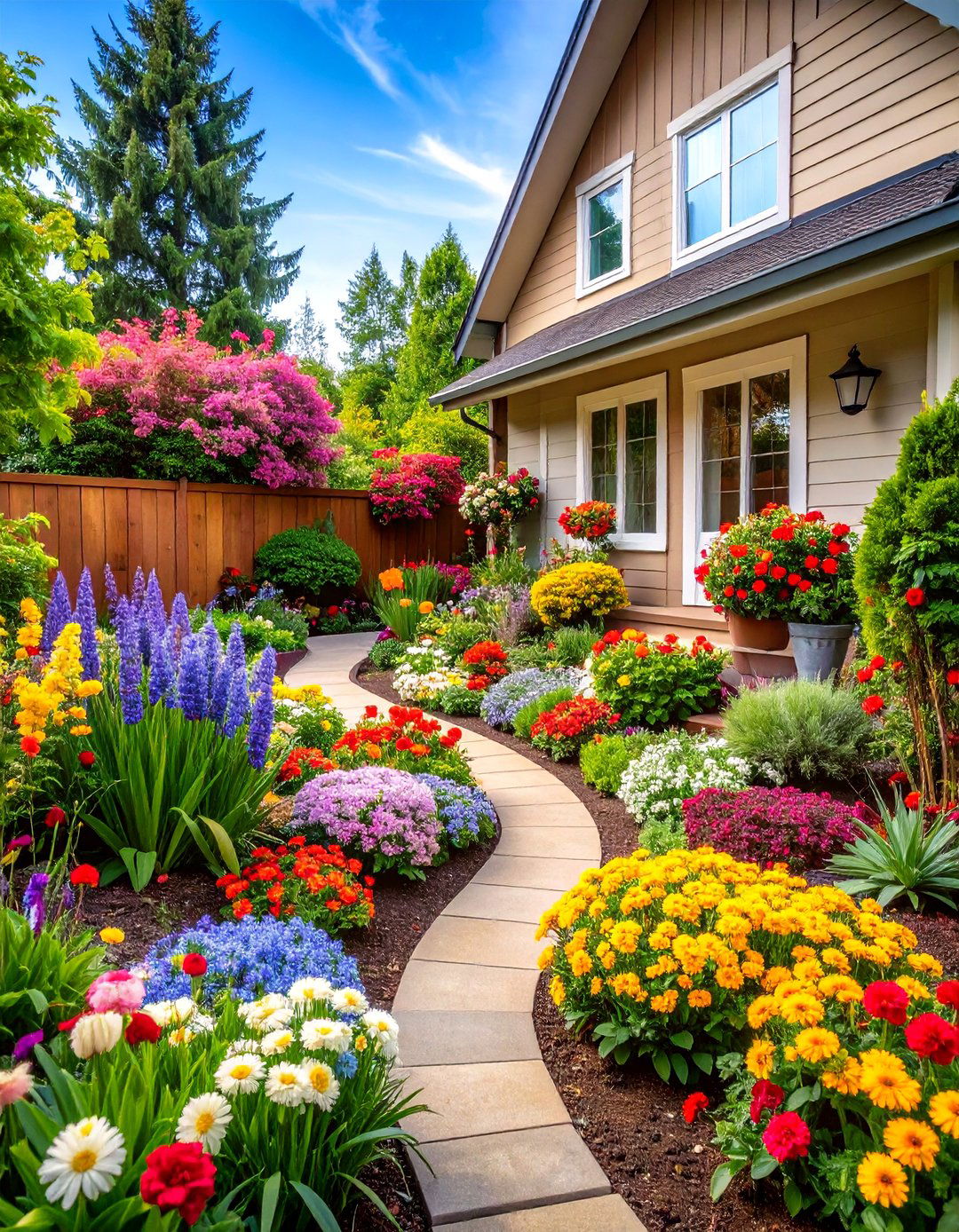
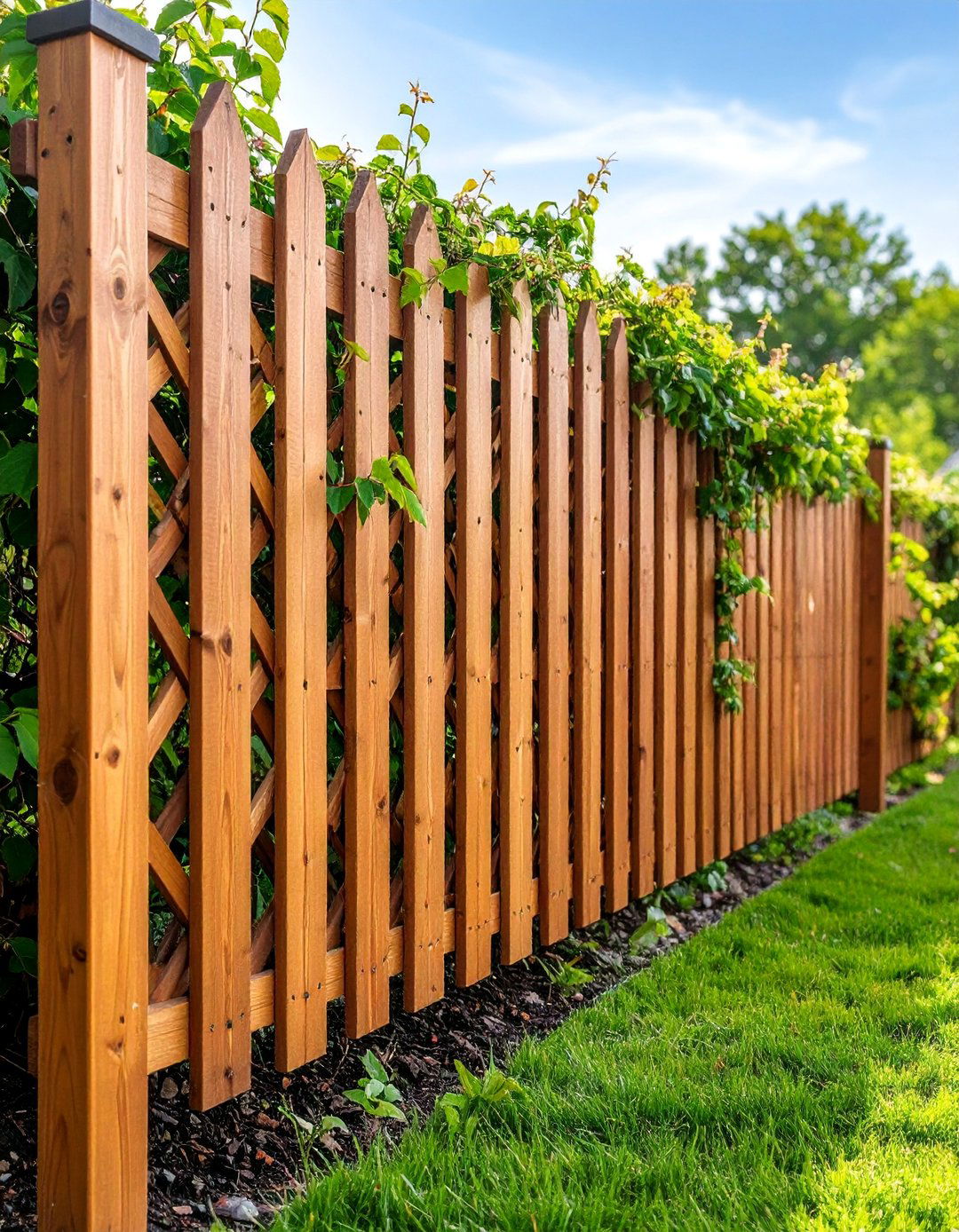
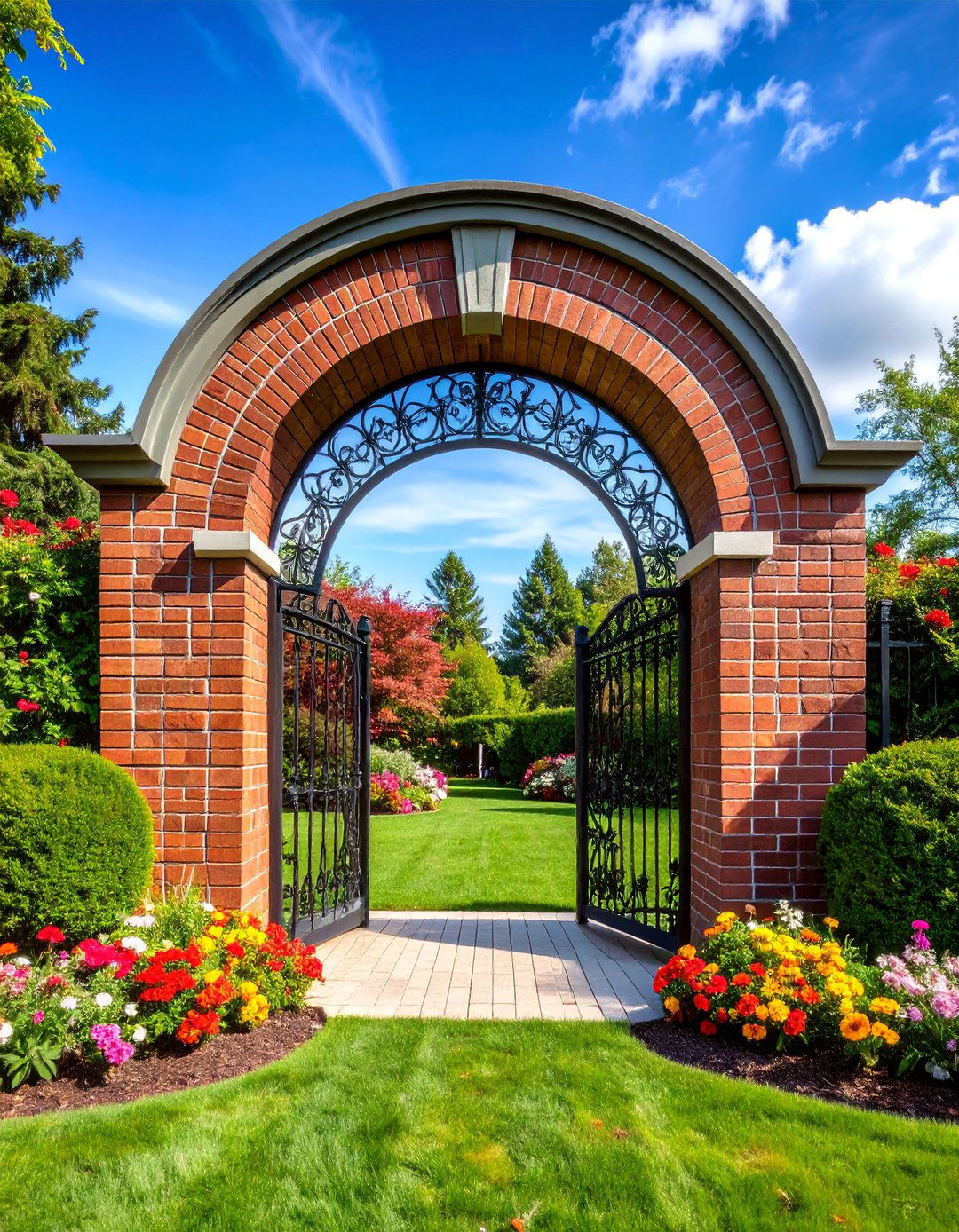
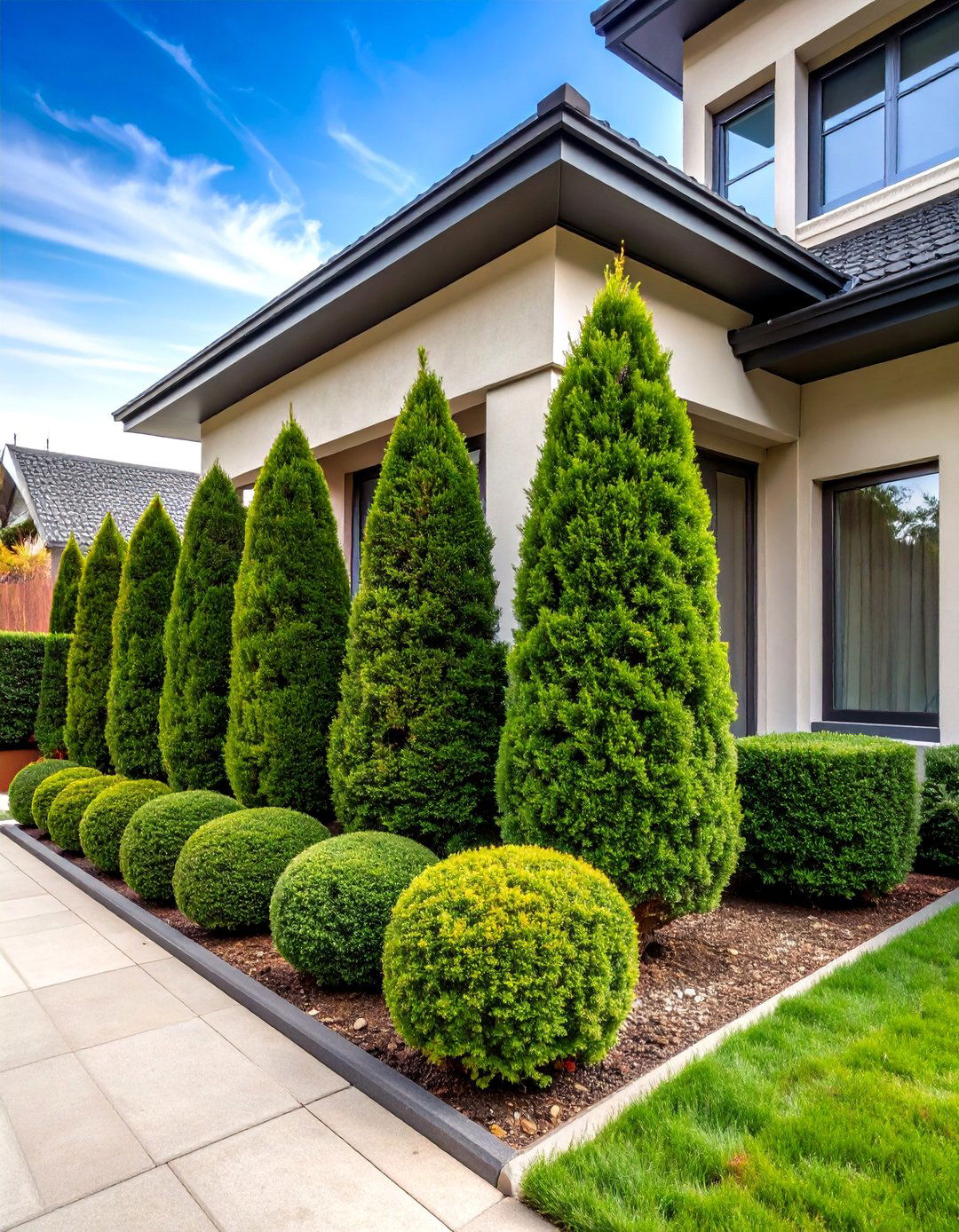





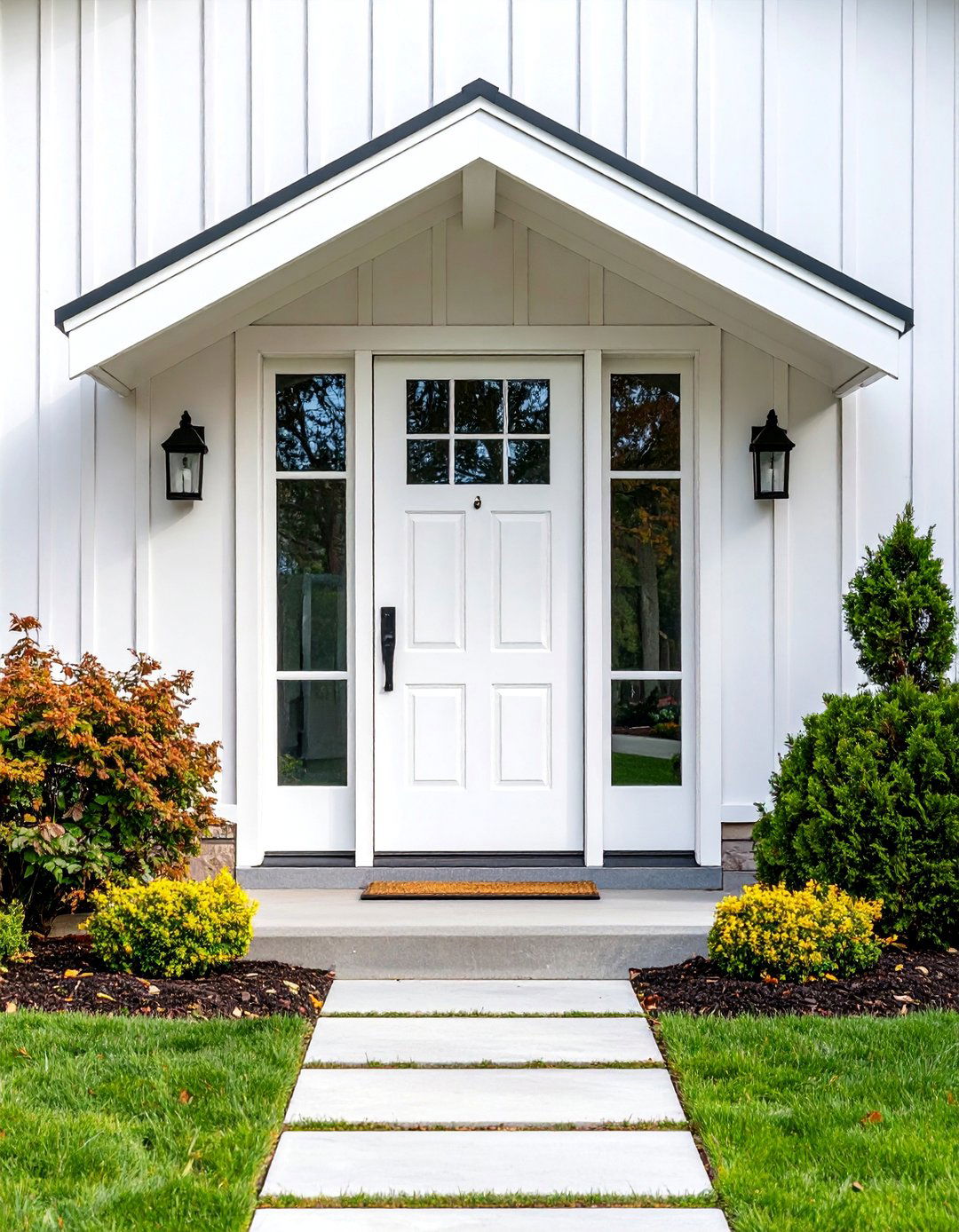
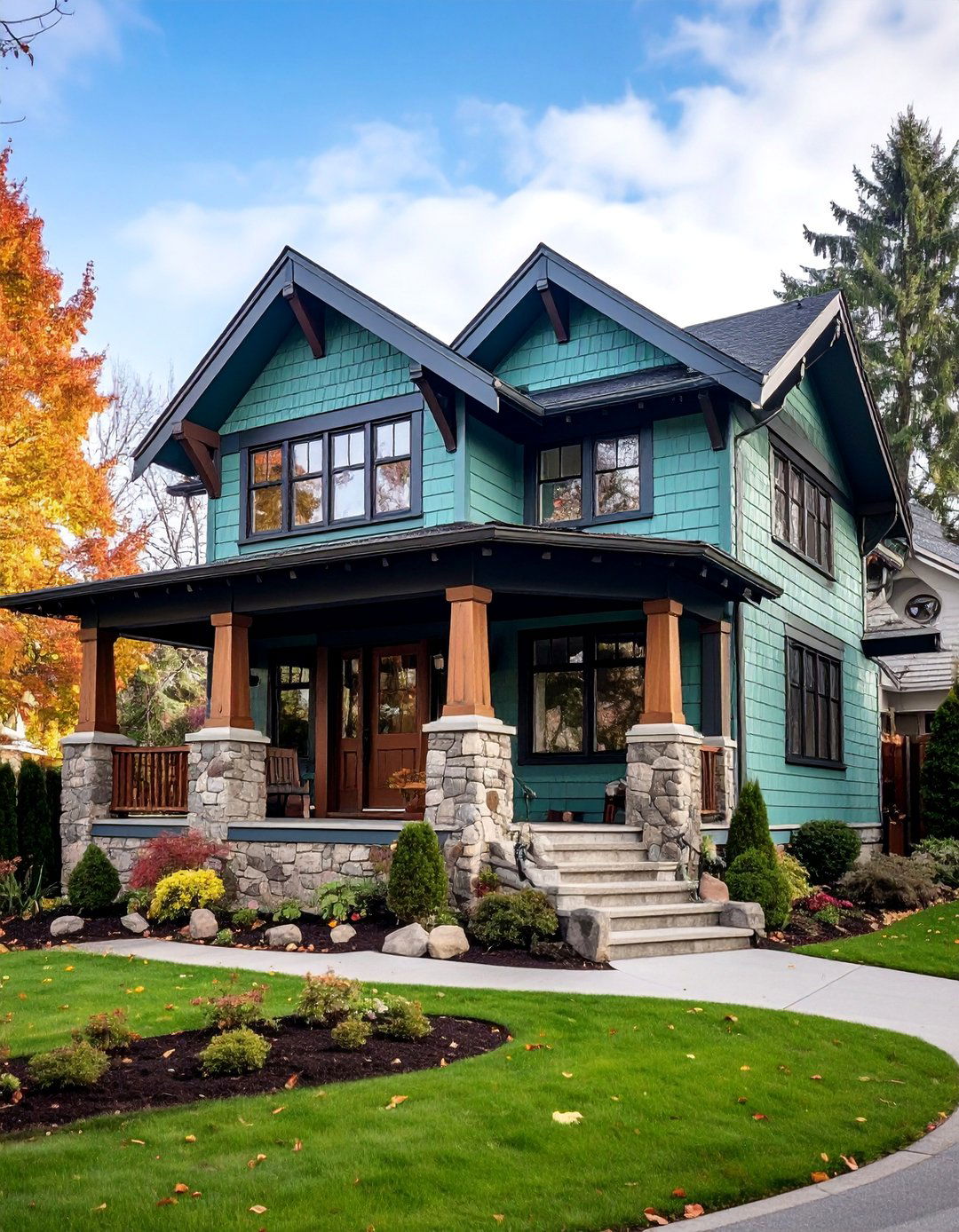
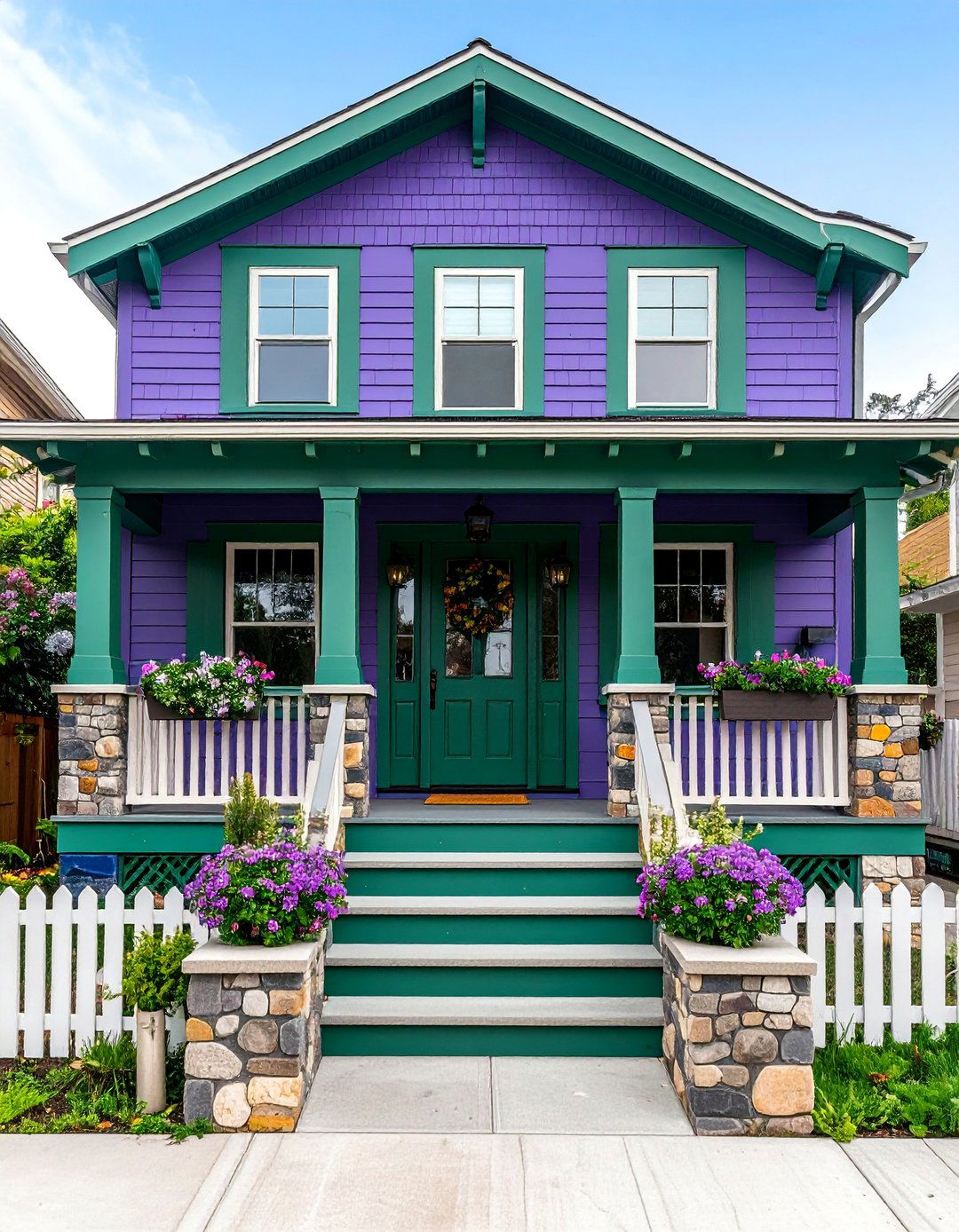


Leave a Reply